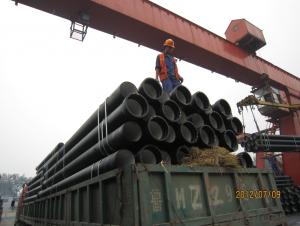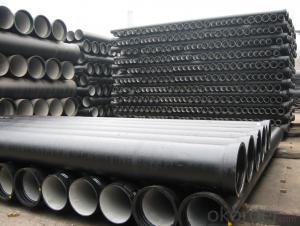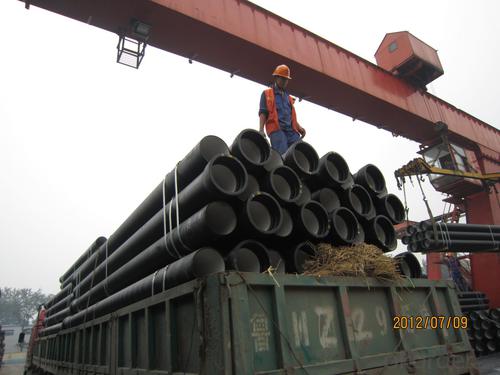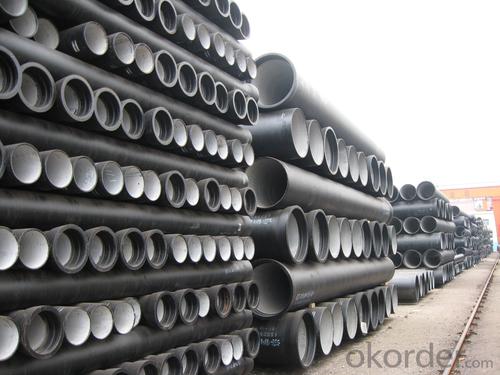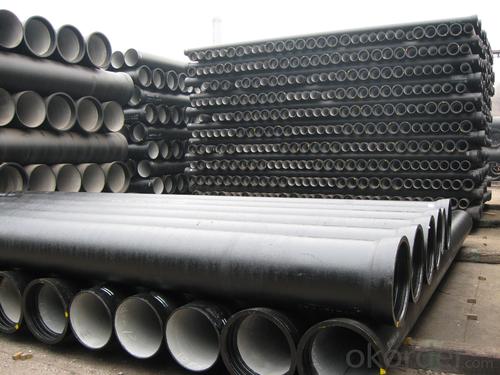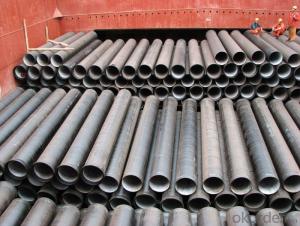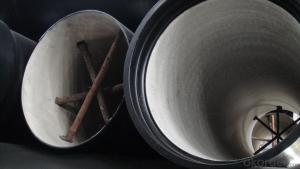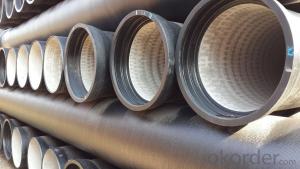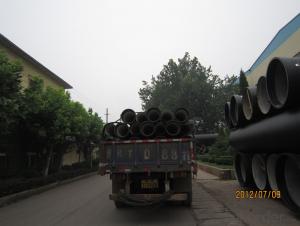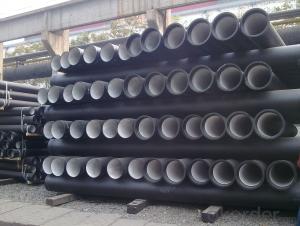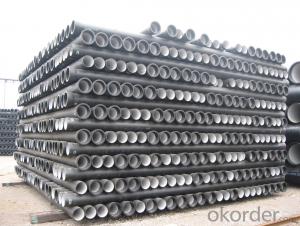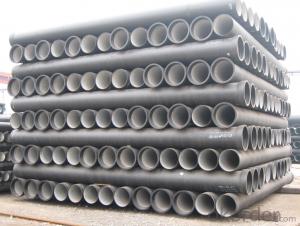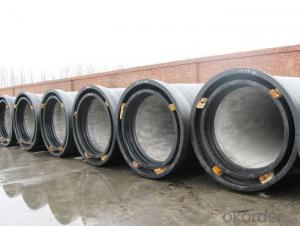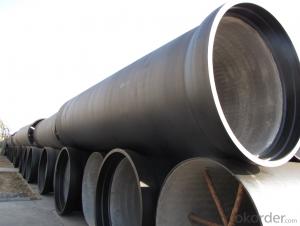Ductile Iron Pipe DN500
OKorder Service Pledge
Quality Product, Order Online Tracking, Timely Delivery
OKorder Financial Service
Credit Rating, Credit Services, Credit Purchasing
You Might Also Like
Specifications
Quick Details
| Place of Origin: | China (Mainland) | Brand Name: | CMAX | Model Number: | T type / K type / Flange type |
| Length: | 6m / 5.7m / Negotiable | Standard: | ISO2531 / EN545 / EN598 | Application: | Potable / Sewage water |
| Diameter: | DN80~DN2200 | Shape: | Round | Hardness: | 230 |
| Pipe Wall Thickness: | standard | Pull Strength: | 420 | Yield (≥ MPa): | 300 |
| Material: | Ductile Iron | Type: | Centrifugal ductile cast iron pipe | Certification: | ISO2531 / EN545 / EN598 |
| Outer Diameter: | 80-2200 | Thickness: | standard | Specification: | DN80~DN2200 |
| |
The advantages to the customer:
Trustworthy financial strength.
One-stop shopping.
Fast and efficient service.
Coordination of shipments from multiple plants.
Specialists of the overseas shipping process.
A more competitive price.
- Q: What are the different types of coatings available for ductile iron pipe?
- Ductile iron pipe offers a range of coating options, each with its own unique properties and benefits. 1. One commonly used coating is cement mortar. It involves applying a layer of cement mortar to both the interior and exterior surfaces of the pipe. This coating protects against corrosion and abrasion, while also improving hydraulic efficiency. 2. Another popular choice is polyethylene encasement. This involves wrapping the pipe with a layer of polyethylene material. It provides excellent corrosion resistance, especially against soil and water contaminants. 3. Fusion-bonded epoxy (FBE) coating is applied by heating epoxy powder to create a strong bond with the pipe surface. It offers outstanding corrosion resistance and is commonly used in aggressive environments like wastewater treatment plants and chemical processing facilities. 4. Zinc coating, also known as galvanization, is applied by adding a layer of zinc to the pipe's surface. It provides excellent corrosion resistance and is often used in outdoor applications exposed to moisture and humidity. 5. Bituminous coating is a black, tar-like substance that protects against corrosion. It is commonly used in underground applications where the pipe is in contact with soil or water. 6. Polyurethane coatings are known for their resistance to abrasion, impact, and chemical corrosion. They are often used in aggressive environments such as oil and gas pipelines. These examples highlight the different coatings available for ductile iron pipe. The choice of coating depends on factors like the intended application, environmental conditions, and desired level of corrosion protection. It is crucial to consult industry experts and follow relevant standards and specifications when selecting a coating for ductile iron pipe.
- Q: Can ductile iron be welded? Is weldability comparable to gray iron?
- The tensile strength of more than or equal to 70000 PSI (more than 482 n / mm2) yield strength: General 62000 (more than 427 n / mm2)Hardness (HB): 185HBWith the parent material color: similar power options: AC and DC dual-use, DC DC reverse connection
- Q: Can ductile iron pipes be used for mining applications?
- Yes, ductile iron pipes can be used for mining applications. Ductile iron pipes are known for their strength, durability, and resistance to corrosion, making them suitable for various industrial purposes, including mining. Their ability to withstand high pressure and handle heavy loads makes them ideal for transporting water, slurry, and other materials commonly used in mining operations. Additionally, ductile iron pipes have a long lifespan, reducing the need for frequent replacements and maintenance in mining environments.
- Q: Are ductile iron pipes prone to leakage?
- Ductile iron pipes are renowned for their leak resistance, owing to their durability and strength. Unlike PVC or cast iron pipes, this type of pipe is less susceptible to leaks. It is designed to endure high pressure and heavy loads, making it suitable for a range of applications such as water supply, sewage systems, and industrial pipelines. The leak resistance of ductile iron pipes can be attributed to their unique properties, including flexibility and shock absorption. With high tensile strength, these pipes can withstand internal and external pressure without cracking or breaking. Moreover, ductile iron pipes boast leak-proof joints. These joints are typically sealed with rubber gaskets and connected using methods like push-on joints or restrained joints with mechanical couplings. These joint designs ensure a secure and watertight connection, minimizing the risk of leaks. Nevertheless, under certain circumstances, ductile iron pipes can still experience leaks. Factors like age, corrosion, improper installation, or ground movement can contribute to leak development over time. Regular maintenance and inspections are crucial in detecting and resolving potential issues that may lead to leaks. In summary, while ductile iron pipes are generally resistant to leaks and renowned for their reliability, proper installation, regular maintenance, and timely repairs are vital to maximize their lifespan and prevent potential leaks.
- Q: What is the exterior anticorrosion of nodular cast iron pipes?
- Spraying anti-corrosion paint, usually first spray a anticorrosive paint, and then primer 2, paint 2!
- Q: What are the common methods for leak detection in ductile iron pipes?
- There are several common methods for leak detection in ductile iron pipes. These methods are widely used by professionals in the field to identify and locate leaks in a timely manner. 1. Acoustic Leak Detection: This method involves using specialized equipment to listen for the sound of water escaping from the pipe. The equipment detects the sound of the leak and helps pinpoint its location. This method is effective for both pressurized and non-pressurized pipes. 2. Visual Inspection: Visual inspection involves physically inspecting the pipe system for any visible signs of leaks such as water stains, wet spots, or puddles. This method is relatively simple and can be effective for detecting visible leaks in accessible areas. 3. Pressure Testing: Pressure testing involves pressurizing the pipe system and monitoring for any drops in pressure. If there is a leak, the pressure will drop, indicating its presence. This method is commonly used during installation or maintenance and can help identify leaks in inaccessible areas. 4. Infrared Thermography: Infrared cameras are used to detect leaks by measuring temperature differences. Water escaping from a pipe can create a temperature difference, which can be detected by the camera. This method is particularly effective for identifying hidden leaks behind walls or underground. 5. Tracer Gas Testing: Tracer gas testing involves injecting a specific gas, such as helium or hydrogen, into the pipe system. If there is a leak, the gas will escape and can be detected using specialized equipment. This method is highly sensitive and can locate even small leaks. 6. Soil Gas Monitoring: This method involves monitoring the soil around the pipe for the presence of gases emitted by leaking water. By analyzing the soil gas composition, professionals can determine the location of the leak. It is important to note that the choice of method may vary depending on the specific circumstances, such as the size of the pipe system, accessibility, and severity of the leak. In some cases, a combination of methods may be used to ensure accurate and comprehensive leak detection.
- Q: How is ductile iron pipe tested for quality?
- Extensive quality testing is carried out on ductile iron pipe to ensure its performance and reliability in various applications. The pipe undergoes a series of steps to assess its physical and mechanical properties. The hydrostatic pressure test is one of the main tests performed on ductile iron pipe. This test involves subjecting the pipe to fluid pressure that exceeds its designed operating pressure. The purpose is to determine if the pipe can withstand internal pressure without any leakage or failure. The pipe is filled with water or another suitable fluid, and the pressure is gradually increased to the required level. During this test, the pipe is carefully inspected for any signs of leakage or deformation. Another essential test is the tensile strength test, which measures the pipe's ability to resist pulling or stretching forces. A sample of the pipe is pulled until it breaks, and the maximum force applied during the test is recorded. This test helps determine important properties such as the pipe's ultimate tensile strength, yield strength, and elongation. The Charpy test is used to assess the pipe's impact resistance. In this test, a notched sample is struck with a swinging pendulum to measure the amount of energy absorbed by the pipe. It helps determine if the pipe can withstand sudden impacts or loads without fracturing. In addition to these tests, the pipe also undergoes various non-destructive tests, including ultrasonic testing, magnetic particle inspection, and visual inspection. These tests are crucial in detecting any internal or external defects, cracks, or abnormalities that could compromise the pipe's structural integrity. Furthermore, chemical analysis and metallographic examination are performed to evaluate the chemical composition and microstructure of the ductile iron pipe. These tests ensure that the pipe meets the necessary specifications and standards for its intended application. Overall, the testing process for ductile iron pipe is thorough and stringent. Its purpose is to guarantee the pipe's quality, durability, and overall performance in safely and efficiently delivering water, wastewater, or other fluids.
- Q: Are ductile iron pipes suitable for use in hydropower projects?
- Indeed, ductile iron pipes prove to be a suitable option for implementation in hydropower projects. Possessing a remarkable tensile strength and corrosion resistance, these pipes emerge as the ideal choice for applications in hydropower projects where water flow and pressure play a significant role. Demonstrating the ability to endure high pressure and boasting durability, these pipes guarantee long-term reliability and safety within hydropower systems. Furthermore, when compared to alternative materials such as steel, ductile iron pipes present a cost-effective solution, rendering them a favored selection for hydropower projects. In summary, ductile iron pipes possess the essential characteristics and performance qualities necessary to meet the rigorous conditions encountered in hydropower projects.
- Q: How to distinguish flexible and rigid interfaces between cast iron pipe joints
- Flexible connections can be kept watertight at any angle (lateral or vertical), and rigid, where the interface of a pipe is easy to crack if a slight earthquake is encountered
- Q: Are there any limitations to the length of ductile iron pipe sections?
- Limitations exist regarding the length of ductile iron pipe sections. Typically, these limitations stem from practical concerns such as transportation, installation, and handling. Longer pipe sections can present difficulties when it comes to transportation and maneuverability, particularly in areas with limited access or challenging terrain. Moreover, longer pipe sections may be more susceptible to damage during installation since proper alignment and joining can be more challenging. Manufacturing capabilities also impose limitations. Ductile iron pipes are typically produced in standard lengths, which can vary depending on the manufacturer and the specific application. These standard lengths are designed to strike a balance between transportation, installation, and overall pipe performance. In addition, longer pipe sections may pose challenges related to temperature variations and subsequent expansion and contraction. Ductile iron pipes are prone to thermal expansion and contraction, and longer sections may experience greater stress and strain as a result. Therefore, while there is no definitive maximum length for ductile iron pipe sections, practical considerations and manufacturing capabilities dictate the use of standard lengths that consider various factors such as transportation, installation, and performance.
Send your message to us
Ductile Iron Pipe DN500
OKorder Service Pledge
Quality Product, Order Online Tracking, Timely Delivery
OKorder Financial Service
Credit Rating, Credit Services, Credit Purchasing
Similar products
Hot products
Hot Searches
Related keywords
